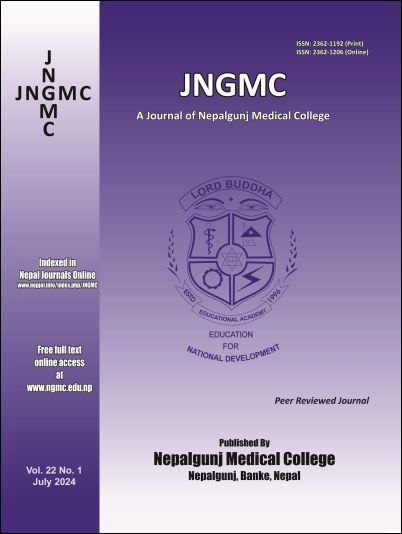Level of Satisfaction on Clinical Learning Environment among Nursing Students of Nepalgunj Nursing Campus at Kohalpur
DOI:
https://doi.org/10.3126/jngmc.v22i1.69706Keywords:
Clinical Learning Environment, Level of Satisfaction, Nursing StudentsAbstract
Introduction: Clinical education is a major component of the undergraduate nursing curriculum. To practice a safe beginning level of nursing care, new graduates must have developed not only the theoretical knowledge on which to base their care but also the practical application skills required to implement that knowledge. The clinical learning environment can have a great influence on the development of attitude, knowledge, skills, and problem-solving ability of students. The clinical learning environment plays a crucial role, especially during the clinical training of student nurses, as they face the reality of their roles and responsibilities of being nurses.
Aims: To find out undergraduate nursing student’s satisfaction with their clinical learning environment.
Methods: This cross-sectional study was conducted in the Nepalgunj Nursing Campus. The study was conducted among 40 students who were studying Proficiency Certificate Level in Nursing at the Nepalgunj Nursing Campus, Kohalpur. A non-probability sampling method was used to select the sample. A semi-structured self-administered questionnaire and the Clinical Learning Environment, Supervision, and Nurse Teacher Scale (CLES+T) were used for data collection. The Clinical Learning Environment, Supervision, and Nurse Teacher Scale is an internationally valid and reliable instrument used to evaluate the quality of clinical learning environments for students in the health professions.
Results: More than half of the nursing students (52.50%) were highly satisfied with the clinical learning environment. The association between the level of satisfaction among nursing students and age, marital status, last clinical placement ward, frequency of meeting nurse teachers, and use of e-communication tools with nursing teachers was not statistically significant.
Conclusion: In today’s education system, which is centered on students’ learning concepts and expectations, assessing the students’ satisfaction level can be one of the innovative ways to bring positive changes to both the students’ and teachers’ experiences. However, the availability of limited research studies on this matter, makes it hard to draw any conclusions. Hence, future studies should focus on identifying the various factors influencing the satisfaction level of students with clinical learning.
Downloads
Downloads
Published
How to Cite
Issue
Section
License

This work is licensed under a Creative Commons Attribution-NonCommercial-NoDerivatives 4.0 International License.
- Attribution - You must give appropriate credit, provide a link to the license, and indicate if changes were made. You may do so in any resonable manner, but not in any way that suggests the licensor endorses you or your use.
- Non Commercial- The materials cannot be used for commercial purposes.
- No Derivatives- If the material is remixed or transformed or built upon, the modified material cannot be distributed.




